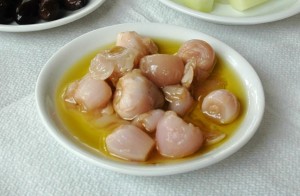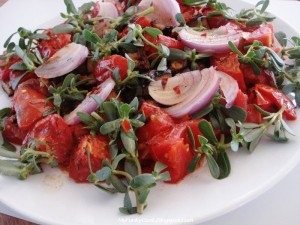The nutritious and therapeutic role of wild herbs in the traditional Greek Mediterranean diet.
Hippocrates, the father of medicine, used to say: Your medicine is your food and your food is your medicine.
Herbs are food, as well as medicine. Hippocrates and Galinos distinguished them in cold and warm and used them in their “Dietetic” therapy, according to the principle of “the opposites”.
In ancient Greece, up until the 17th century, lettuce, suffron, bulbs, purslane, asparagus and chicory belonged in the same category as sage, marjoram and oregano.
Rural populations of Greece consume more than 80 kinds of wild herbs, mainly in the “Cretan Diet“, for nutrition and therapy, without discriminating herbs from vegetables, since the Minoan period, 3000BC.
An example of that is the large group of wild bitter plants. There is also a popular saying: “What is bitter in the mouth is sweet to the body”.
In the older days people used to eat more the bitter components from roots, vegetables or herbs. This habit has almost disappeared in the modern western diet, which shows obviours preference for the sweet and savory flavors.
The main effects of the wild bitter plants are:
- Appetizing
- Saturation of food
- Detoxifying the liver
- Diuretic and
- Tonic
Important bitter wild plants of the Mediterranean Diet:
1. Wild chicory (Chichorium intybus). Dioskourides mentions wild chicory for its diuretic poperties. The monk Agapios the Cretan writes in the book “Geoponikon” that it cleanses the liver.
Chicory comes from the Mediterranean. It was cultivated in Egypt, in 4000BC. Its florets have a light blue color. Edible and useful are the root and its root and sprouts, which are usually consumed with oil and vinegar.
It is rich in minerals (K, Na, Ca, P, Mg, Fe) and vitamins (A, riboflavin, niacin, C)
Pharmaceutical properties: It is bitter, tonic, diuretic and laxative. The extract of its spores protect the liver. The juice of wild chicory leaves have hypoglycemic action. Finally, it has anti-asthmatic and anti-inflammatory properties.
The popular “stamnagathi”, which is a kind of chicory that grows along the coasts of Crete (Chichotium spinosum), has all the porperties mentioned above, while it contains linolenic acid, which is beneficial for the heart.
2. Dandelion, the wild lettuce (Taraxacum officinale). The Arab herbalists imported it to Europe. It is bitter, tonic and bile conducting. Its root and leaves are edible. The dandelion leaves are diuretic, as they replenish the lost potassium. In general, the roots of the plants (when consumed raw) cleanse the blood and have a laxative effect. From the root of this plant people used to brew a beverage (coffee substitute).
Dandelions are rich in vitamins, especially vitamins A and C, and minerals (Fe, Mg, Ca and K). It also contains taraxacin, which stimulates the liver and increases the flow of bile.
Pharmaceutical properties: It stimulates the appetite and helps with indigestion. It also protects the liver.
3. Wild artichoke (Cynara cardunculus). The ancient Greeks and Romans used it in their meals as an aphrodisiac. It origins from North Africa. The edible parts of the artichoke are the tender shoots, the stalk of the leaves and the leaves. The artichoke is bile conducting, it is tonic for the liver, it is diuretic and it protects from atherosclerosis. It regenerates the blood and causes sweating. It is a source of vitamins (A, B and C), minerals (Ca, P and K) and antioxidants (b-carotene, lutein and zeaxanthine), as well as flavonoids.
In 2008, a study that took place in Harokopeio University – which is the only study about wild greens of cretan diet – studied the effect of wild artichoke in the postprandial levels of biochemical markers for cardiovascular diseases. The subjects where given a meal, consituted of boiled grass of wild artichoke with refined olive oil, lemon and bread. The results showed a decrease in insulin and glucose, with a slight increase of triglycerides (metabolic syndrome).

4. Bulbs (Muscari comosum). They origin from the Mediterranean basin. They are found throughout Greece. They are collected by digging, because they are deep in the ground, and they are served boiled as a salad. They can also be preserved in brine and vinegar. Bulbs used to be a treasured delicacy of the ancient Greeks. The pink ones are very bitter. Dioscourides mentions them as a treatment of gout and joint pains. They are also considered to be aphrodisiac, when cooked with honey, vinegar and sesame.
5. Purslane (Portulaca oleracea). It can be found throughouth Greece and the Meidterranean. It was refreshing properties and is mostly used in salads. Theofrastos recommends it as a drug for heart failure. Dioskourides recommends purslane for headaches, stomach ulcers and spleen deseases. Galinos uses the juices of its leaves as a medicine. Recent studies justify the latter, as it is proved that purslane is rich in linolenic acid, as well as EPA. It helps in achieving a balanced ratio of essential fatty acids, thus protecting the heart. Linolenic acid is considered the key of the longevity of the Cretan population in the famous Seven Countries Study. The whole plant contains: B-carotene, vitamins C, B and B2, minerals (Ca, Mg, Na and K), organic acids (nicotinate, oxalate), noradrenaline and biflavonoid liquitinin. Traditionally, they use the juice of purslane to treat inflammations, ulcers and hemorrhoids.
6. Nettle (Urtica dioica). The hairs on the leaves of these plants cause intense itching and hives. Dioskourides mentions nettle as a beverage, made from the leaves of the plant, with diuretic properties. The tender parts of the plant are edible and are mostly used in pies. Nettle is considered to be an aphrodisiac, mainly when boiled. It is rich in minerals, such as silicon (Si) and iron (Fe), which makes it valuable to anemic people. It is also rich in beta-carotene, so it is considered to prevent cancer cells from developing.
Pharmaceutical properties: It is blood cleansing, as well as blood productive. It stimulates the function of bile and liver. Finally, it stimulates bowel movement.
7. Cervil of Arcadia (Scandix pecten veneris L.). 10 of the 12 species of cervil that exist can be found in Mediterranean countries. It is usually consumed in pies or green salads, due to its strong taste. Dioscourides used it to facilitate bowel movements, as well as a diuretic. It was also used to stimulate the sexual ability of the elderly. From a culinary point of view, greens are divided in two major categories:
1.boiled with oil and vinegar, as a salad: chicory, dandelions and
2.Aromatic greens used in pies or cooked with oil.
Cervil belongs to the second category.
Conclusion:
Greek and mainly Cretan flora, which constitutes a third of the Greek flora, is considered to be one of the richest in Europe. Traditional Greek diet is based on olive oil, having as a result great antioxidant capacity (squalene, tocopherols). Mediterranean diet is supplemented with the wild greens, which are herbs with great nutritional value and therapeutic properties, contributing in the treatment of metabolic and other disorders. Finally, the antioxidant shield is completed with the frequent use of beverages and aromatic herbs, to optimize our health and well-being.















{ 0 comments… add one now }